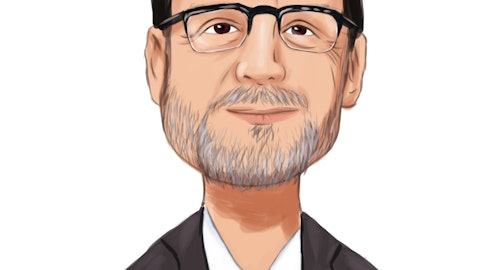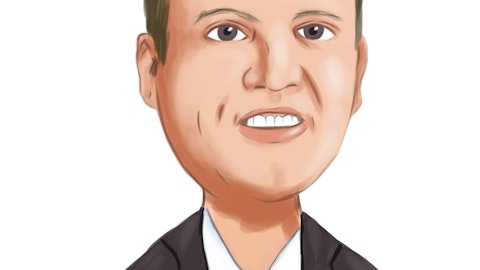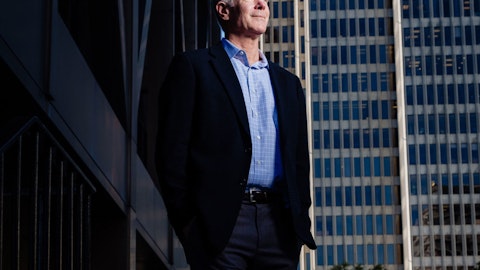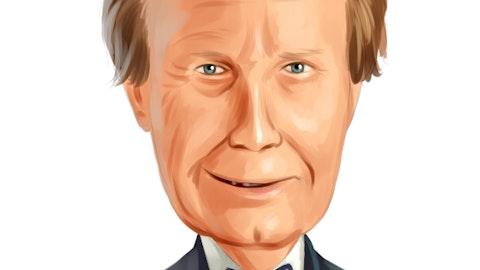Manhattan Associates, Inc. (NASDAQ:MANH) Q4 2022 Earnings Call Transcript February 2, 2023
Operator: Good afternoon. My name is Robert, and I’ll be your conference facilitator today. At this time, I’d like to welcome everyone to Manhattan Associates Fourth Quarter Earnings Conference Call. All lines have been placed on mute to prevent any background noise. After the speakers’ remarks, there will be a question-and-answer period. As a reminder, ladies and gentlemen, this call is being recorded today, February 2. I would now like to introduce your host, Mr. Michael Bauer, Head of Investor Relations of Manhattan Associates. Mr. Bauer, you may begin your conference.
Michael Bauer: Thank you, Rob, and good afternoon, everyone. Welcome to Manhattan Associates 2022 fourth quarter earnings call. I will review our cautionary language and then turn the call over to Eddie Capel, our CEO. During this call, including the question-and-answer session, we may make forward-looking statements regarding future events or the future financial performance of Manhattan Associates. You are cautioned that these forward-looking statements involve risks and uncertainties, are not guarantees of future performance and that actual results may differ materially from the projections contained in our forward-looking statements. I refer you to the reports Manhattan Associates files with the SEC for important factors that could cause actual results to differ materially from those in our projections, particularly our Annual Report on Form 10-K for fiscal year 2021 and the risk factor discussion in that report as well as any risk factor updates we provide in our subsequent Form 10-Qs. We note, in particular, the turbulent global macro environment could impact our performance and cause actual results to differ materially from our projections.
We are under no obligation to update these statements. In addition, our comments include certain non-GAAP financial measures in an effort to provide additional information to investors. We have reconciled all non-GAAP measures to the related GAAP measures in accordance with SEC rules. You’ll find reconciliation schedules in the Form 8-K we submitted to the SEC earlier today and on our website at manh.com. Now I’ll turn the call over to Ed.
Eddie Capel: Okay. Thanks, Mike. Well, good afternoon, everyone, and thank you for joining us as we review our fourth quarter and full-year 2022 results, as well as our outlook for 2023. So 2022 is a remarkable year for Manhattan, setting all-time records in total revenue, RPO, operating profit, cash collections and earnings per share. And to drive future growth and innovation, we also invested record amounts in our people and in R&D. In 2022, we spent over $110 million on research and development, which is up 15% from the previous year. We also increased our total headcount by 16% in response to the high demand for our solutions and services. We are confident that these investments will contribute to our already high levels of customer satisfaction and extend our position as the leading innovator in core supply chain execution, omnichannel solutions and retail point-of-sale commerce.
And given the size of our opportunity and the long-term favorable business momentum, we plan to continue the investments, including hiring between 400 and 600 new associates in 2023, which we are guiding to be our fourth record revenue year since introducing our goal to become a cloud-first company five years ago. Now while we remain appropriately cautious regarding the global economy, demand for our solutions remains robust, and we are optimistic about our long-term market opportunity. Now recall our solutions are mission-critical and they are key components to our customers’ success. And additionally, we are entering 2023 with pretty good visibility in several growth drivers, including, the acquisition of new customers; the conversion of our on-premise customers to the cloud; and cross-selling our unified product portfolio into our customer base.
Now specifically pivoting to our quarterly results, Q4 was a record quarter that exceeded our expectations. Revenue increased 16% as a reported $198 million and highlighted by 49% growth in cloud, 22% growth in services and double-digit revenue growth across all of our geographies. And these strong results drove our topline outperformance and solid earnings leverage in the quarter with adjusted earnings per diluted share increasing 69% to $0.81. Now RPO, the leading indicator of that growth, increased 50% to $1.1 billion at the end of 2022. And importantly, customer satisfaction levels are high. Win rates remain at 75% plus, and demand for our cloud solutions continues to be pretty solid across our product portfolio. From a vertical perspective, retail, manufacturing and wholesale continue to drive more than 80% of our bookings in the quarter.
And across our solutions, the sub-verticals are pretty diverse. For example in the quarter, cloud deals won include a global cosmetics manufacturer, a grocery retailer, a diversified automotive company, a manufacturer of home goods, a food wholesaler and an e-commerce retailer as well as numerous others. And this contributed to a healthy mix of bookings across sub-verticals for the full-year. And additionally, aided by the clear benefit of resilient modern supply chains, over 40% of our bookings were generated from new logos and over 30% from cross-sell opportunities in 2022. Importantly, that pipeline continues to be strong with solid demand across our product suites. Net new potential customers represent about 35% of that demand. And as of year-end, we had converted less than 10% of our on-premise customers to the cloud.
Now turning to the product front. We are coming off of a very exciting National Retail Federation Conference in New York. Customers and prospects were back in force this year, and we have some exciting product innovations to share with them. Those include the work we are doing around fully enabling RFID with our Manhattan Active store solution. We’ve added native support for RFID directly into checkouts and returns, inventory management and store fulfillment functions so that retailers can make more accurate promises, increased conversion rates and maximize inventory exposure for selling. The value of RFID in stores has proven to be quite significant as the digital experience becomes an integral part of bricks-and-mortar shopping. It’s vital that our customers know how much of a particular product that they have and where each specific unit is located inside of their store.
And what’s more, RFID allows our customers to deliver these improved experiences and to do it with significantly less labor. Now speaking of our store technology, we just finished a very successful retail peak season, and specifically with our point-of-sale application. A number of our customers are showing very positive results from the rollout of our Omnicart capabilities. That’s the ability to sell items from alternate locations in a single transaction. And only a unified commerce solution with a built-in point-of-sale and order management capabilities can deliver a seamless Omnicart process. Now regarding implementations, we are seeing some really very positive operational results tied to the first wave of deployments of Manhattan Active Warehouse Management.
And I thought I’d share a couple of anecdotes on the positive operational impact from the deployments of our cloud-native WMS. Now I’ve spoken before about employee engagement, one of the WMS features, which is unique to our application. And one of our early adopter Manhattan Active WM customers who now activated all the features of employee engagement, including enabling their associates to complete in gamified challenges and accumulate points. And these points are redeemable for a variety of tangible items in a digital incentive store. And the result for this customer is an incremental 5% productivity improvement in the DC on top of their traditional engineered labor standards and incentive program. And staying on productivity enhancements for a moment, one of our high-volume apparel customers in Brazil is showing a double-digit throughput increase in their distribution center after implementing Manhattan Active WM.
Even though the facility was already outfitted with pretty extensive automation, the workflow optimization inside of Manhattan Active WM is helping them extract record levels of productivity from their material handling automation. Now even in a less automated DC, Manhattan Active WM really shines there, too. One of our large wholesale drug customers is reporting a picking productivity improvement in excess of 30%, and this improvement is attributable to the latest pick path optimization algorithms native to Manhattan Active WM. Now before I hand off to Dennis, I want to take this opportunity to briefly recognize and thank each and every member of the Manhattan global team. And Manhattan is committed to creating an inclusive culture where our team members can advance their careers, contribute to our company-wide goals, feel valued and engaged with the communities in which they live and work.
And in 2022, they clearly went above and beyond to deliver a remarkable year with remarkable results for our valued customers. And I’m confident in the future success of this company largely because of this team. So that includes or concludes my business update. Dennis is going to provide you with an update of our financial performance and outlook. And then I’ll close our prepared remarks with a brief summary before we move to Q&A. So Dennis?

Photo by Damir Kopezhanov on Unsplash
Dennis Story: Thanks, Eddie. As Eddie highlighted in 2022, we set all-time records in RPO, total revenue, operating profit, cash collections and earnings per share. Congratulations to our team members around the globe for great execution. Overall, for the quarter and the year, we delivered a strong balanced financial performance on topline growth and operating margin, with both results comparing favorably to the Rule of 40 and if our revenue growth is normalized for our cloud transition, excluding license and maintenance attrition, both results exceed the Rule of 50. We continue to deliver strong metrics across revenue growth, profitability and cash flow. I’ll start with recapping our financial performance for the quarter and year.
All growth rates are on a year-over-year basis unless otherwise stated. Additionally, we are also providing constant currency growth to demonstrate apples-to-apples comparisons. Unless otherwise stated, constant currency will compare results as if rates were unchanged from the year ago period. Q4 total revenue was $198 million, up 16% as reported and 19% excluding FX. Full-year revenue totaled $767 million, also up 16% and 18% removing FX. Excluding license and maintenance revenue, which removes the revenue compression by our cloud transition, Q4 revenue growth was 29% and full-year 25%. Q4 cloud revenue totaled $52 million, up 49%, with full-year revenue totaling $176 million, up 44%. We closed out 2022 with RPO of $1.1 billion on the round, growing 50%.
This was at the high end of our guidance. If FX rates remain unchanged from the year ago period, RPO growth would be 54%. And if rates remained unchanged from September 30 levels, sequential RPO growth would be 6%. As of December 31, over 97% of our RPO represents true cloud-native subscriptions. Q4 services revenue increased 22% to $100 million, and full-year services revenue increased 18% to $394 million. Both were records as cloud sales continue to fuel services growth globally. Shifting to earnings leverage. Our Q4 adjusted operating income totaled $60 million with an operating margin of 30.2%. The 740 basis point increase was driven by revenue growth. Full-year adjusted operating margin was 27.6%, up 80 basis points on revenue growth. Our Q4 GAAP operating income was $45 million with a 22.6% operating margin, with full-year GAAP operating income totaling $153 million with a 20% operating margin.
Our Q4 earnings per share increased 69% to $0.81. Note, our EPS includes $0.05 of tax benefit associated with expiring tax statutes, lowering our effective tax rate in the quarter to 16%. This resulted in full-year EPS of $2.76, which was up 24%, exceeding guidance. Q4 operating cash flow increased 38% to $55 million as Q4 adjusted EBITDA margin was 31% and free cash flow margin was 26.6%. Our full-year operating cash flow was $180 million. Adjusted EBITDA margin was 28.5% and free cash flow margin was 22.6%. Remember, these figures include $58 million in cash taxes paid, which is roughly doubling the amount of cash taxes paid over last year. For more information on the $26 million incremental cash taxes paid associated with the U.S. Tax Cuts and Jobs Act, please refer to Item 8 in our earnings supplemental information schedules.
Turning to the balance sheet, deferred revenue increased 36% year-over-year and 23% sequentially to $209 million. We closed 2022 with $225 million in cash and zero debt. For the year, we invested $175 million in share buybacks, including $25 million in Q4. Also, our Board has approved the replenishment of our $75 million share repurchase authority. Now moving to guidance. As consistently mentioned, our financial objective is to deliver sustainable double-digit topline growth and top quartile operating margins benchmarked against enterprise SaaS comps. As Eddie mentioned, we will continue to invest with a balanced approach to growth and profitability. We are raising the midpoint of the preliminary 2023 revenue, operating margin and EPS guidance that we provided last quarter.
We are also reiterating our 2023 RPO guidepost midpoint of $1.35 billion. Consistent with our recent earnings releases, our guidepost can be found in today’s earnings release, supplemental schedules. As noted on prior earnings calls, we will be updating our RPO outlook on an annual basis. Additionally, as previously discussed, our bookings performance is impacted by the number and relative value of large deals we close in any quarter, which can potentially cause lumpiness or nonlinear bookings throughout the year. For full-year 2023, we expect total revenue of $820 million to $833 million with an $826.5 million midpoint, up from our prior midpoint of $810 million. Excluding license and maintenance attrition, this represents 16% growth. All in, our target is 8%.
First half and second half total revenue splits are expected to be about 50-50. For Q1, we expect total revenue of $198 million to $202 million, which at the midpoint represents 21% growth, ex license and maintenance attrition and 12% growth all in. We continue to track ahead of our original margin expectations. And reflective of our higher revenue outlook, we are increasing our 2023 adjusted operating margin range to 25.5% to 26.5%, with a midpoint of 26%, up from our prior guidance of 25.5%. Included in this range is a 260 basis point headwind from the $35 million reduction in maintenance and license revenue from our transition to cloud. At the midpoint, operating margin on a quarterly basis is expected to be roughly: For Q1, 26%; Q2, 26.8%; Q3, 27%; and accounting for retail peak seasonality, 24.3% in Q4.
Those are pretty exact targets. This results in a full-year adjusted EPS range of $2.61 to $2.75. The $2.68 midpoint, up from our prior $2.55 midpoint outlook for GAAP EPS, our guidance range is $1.81 to $1.95. Note, if the 2022 below-the-line income taxes and other income were normalized at 2022 levels, 2023 adjusted EPS would be $0.13 higher and GAAP EPS would be $0.14 higher. For Q1, we expect adjusted EPS of $0.64 to $0.66 and GAAP EPS of $0.46 to $0.48. For Q2 through Q4, we expect GAAP EPS to be about $0.20 lower than adjusted EPS per quarter, which accounts for our investment in equity-based compensation. Here are some additional details on our 2023 outlook. For full-year 2023, we are increasing our cloud revenue range to $232 million to $236 million, representing 33% growth at the midpoint and assumes $53.8 million in Q1 with about a $3 million sequential increase per quarter throughout the year.
For services revenue, we are increasing our forecast of $428 million to $437 million, representing 10% growth at the midpoint. On a quarterly basis, we expect Q1 services revenue of roughly $103 million; Q2, $111 million; Q3, $114 million; and accounting for retail peak seasonality, $106 million in Q4. On attrition to cloud, we expect maintenance and license to represent about an 8-point headwind in total revenue growth in 2023. For maintenance, we expect a range of $122 million to $124 million, or a 14% decline at the midpoint. On a quarterly basis, we expect Q1 to be $33 million; Q2, $32 million; Q3, $30 million; and Q4, $28 million. We expect license revenue to be roughly $9 million or 1% of 2023 total revenue. For Q1, we expect $3.5 million of license revenue; $2.5 million in Q2; and $1.5 million in both Q3 and Q4.
And for hardware, we anticipate approximately $7 million in revenue per quarter. For consolidated subscription, maintenance and services margin, we are targeting about 54% for the full-year. On a quarterly basis, Q1 will be about 53%, Q2 and Q3 is expected to be 54.5%. And accounting for seasonality, Q4 is expected to be about 53.5%. We expect our effective tax rate to be 21.7% and our diluted share count to be 63 million shares, which assumes no buyback activity. In summary, 2022 was a great year, and we expect 2023 to be another year of balanced growth across revenue, profitability and cash flow. Thank you. And back to Eddie for some closing remarks.
Eddie Capel: Terrific. Thanks, Dennis. Well look, 2022 was a very good year for Manhattan. And while we remain appropriately cautious, as I mentioned on the volatile macro conditions out there, we are entering 2023 with solid business momentum, and we are very excited about the many opportunities that lie ahead. So just to recap, our strategic demand for our solutions is solid and seems to be resilient. Our global teams are executing very well, and we are continuing to invest in our business to deliver leading innovation to help our customers with their digital and supply chain transformation journeys. In closing, again, thank you to all of our employees across the globe for a fantastic 2022 as your dedication and commitment to our growing customer base that continues to be one of Manhattan’s key differentiators. And Robert, with that, we are now ready to take any questions that might be out there.
See also 25 Lowest PE Stocks of S&P 500 Index and 19 Biggest Outdoor Brands and Companies .
Q&A Session
Follow Manhattan Associates Inc (NASDAQ:MANH)
Follow Manhattan Associates Inc (NASDAQ:MANH)
Operator: Thank you. At this time, we will be conducting a question-and-answer session. Our first question comes from Terry Tillman with Truist Securities. Please proceed with your question.
Terrell Tillman: Yes. Hey, Eddie, Dennis and Mike. Congratulations on the results. I’m going to do my standard annoying preamble, and then I’ll kind of get to my questions. First, Eddie, I love kind of the different examples of the customers. That helps a lot in terms of understanding how the business has evolved. So I hope you keep doing that. Dennis, modeling, basically, we don’t really have anything to do. You basically told us every line item across all four quarters. So thanks for making that easy. Now finally, to my questions. Maybe the first question for you, Eddie, is just given what you’ve done with the platform, the cloud products, and just nowadays the business models are a lot different and you have omnichannel, when you bring on a new logo and you’ve been bringing on more than you had in the past, what does the new logo look like versus three or five years ago in terms of the size and scope of that initial deal or project?
And then I had a follow-up for you Dennis.
Eddie Capel: Yes. Great question, Terry. So it tends to be a little bit different. In the old world of license revenue, it was more typical for customers to buy multiple products at the same time. In a subscription-based world, it seems to be more popular, not exclusively this way, but more popular, frankly, to buy one product at a time with follow-on upsell later. And you can kind of see that in the results with 30% of our revenue coming from upsell. And that, I think, is also indicative of the unified platform that we have and the bridge from one solution to the other is frankly not very long.
Terrell Tillman: Okay. And maybe my follow-up for you, Eddie, and then I had a quick for Dennis. You actually did mention in your prepared remarks visibility for solid or strong visibility, I forgot exactly the description there. But what I’m curious about is you do have the installed base, and we’re going to see this maintenance start to kind of decline maybe more meaningfully, so that’s one driver. And then the cross-selling. How is the visibility changing or improving? Is one much more notable than the other in terms of driving this visibility?
Eddie Capel: You mean customer base versus new logos?
Terrell Tillman: No installed base now starting their journey versus then cross-selling. And like you had just said, they get going and then there’s repetition to buy more.
Eddie Capel: Yes, I don’t think there’s a huge difference in visibility or frankly, confidence of visibility, only because we’re pretty close to our customers, Terry. And whether it be an on-premise to cloud conversion, or whether it be an expansion of capability inside the customer base, we’re pretty close. We’ve got long-term relationships with these guys. And generally, they share their road map with us. So no big difference in visibility across the two.
Terrell Tillman: Okay. And then finally for you, Dennis, in terms of the free cash flow margin, maybe you could either answer or give a perspective on how to think about free cash flow margin for the year, or just incremental headwinds on that $56 million plus in cash taxes in 2022 and how that looks in 2023? Thank you.
Dennis Story: Yes. So on the free cash flow, it’s going to follow a point or two relative to our operating margin. So I would probably handicap it as two to three points difference between operating margin. And then I’m sorry, Terry, what was your other?




